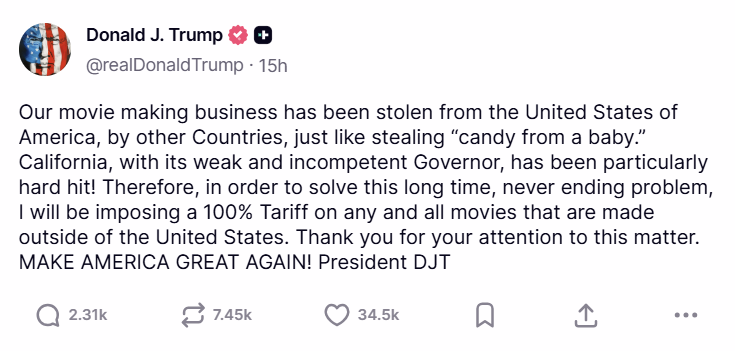President Donald Trump announced on Monday that the United States will impose a 100 per cent tariff on all movies made outside the country. He accused other nations of “stealing” the American film industry and singled out California for losing production to foreign locations.
The move aims to protect U.S. jobs and revive domestic filmmaking but has sparked strong industry backlash with concerns over enforcement difficulties, rising costs for consumers, and harm to global film cooperation. Details on implementation timelines remain unclear, and streaming services also face potential tariffs.

Trump’s Protectionist Tariff on Foreign Films
In a post on Truth Social, President Trump declared, “Our movie making business has been stolen from the United States of America by other Countries, just like stealing candy from a baby.” He said this 100% tariff will apply to “any and all movies that are made outside of the United States,” citing California’s state government as particularly weak in protecting the industry.
The White House framed the tariff as a way to restore American film dominance and safeguard jobs. However, the measure has thrown the global entertainment business into uncertainty, with major studios and streaming platforms like Netflix warning it could disrupt distribution and increase costs.
Complexities of Modern Film Production
The film industry today is highly global, with movies often produced across multiple countries simultaneously. Experts highlight that a Hollywood film may outsource visual effects to a studio in India, edit in another country, and complete sound mixing elsewhere.
This complexity makes it extremely difficult to determine which movies qualify as foreign under the tariff rule. Producers and industry insiders are baffled about how such a tax can be enforced legally or practically. Moreover, many U.S. productions shoot overseas to benefit from tax incentives, underscoring the challenges of defining “Made in America” in filmmaking.
Impact on International Film Markets
The tariff could severely affect India’s film market, the largest globally by volume, which earns significant revenue from U.S. box office and streaming markets. Telugu, Bollywood, Tamil, and Malayalam films represent sizable shares of the American diaspora’s entertainment consumption, with Indian films bringing in hundreds of millions annually.
Industry voices warn doubling import costs could lead to higher ticket prices and reduced viewership. Similar concerns apply to European, Asian, and Australian film industries, risking a downturn in cultural exchange and international investment. Hollywood itself may suffer losses as global collaboration diminishes.
In 2025, the U.S. film market is dominated by action, adventure, and superhero genres, accounting for over half of box office revenues. Despite industry challenges, demand for diverse content remains strong, driven by younger audiences and streaming platforms. The film market is projected to grow steadily, underscoring the economic importance of open and collaborative international film exchanges.
The Logical Indian’s Perspective
Cinema transcends borders and enriches societies by sharing diverse cultures, ideas, and stories. While it is crucial to protect local creative sectors and jobs, aggressive tariffs threaten to narrow artistic diversity and limit cultural dialogue.
Creative industries thrive on collaboration and the free flow of ideas, not isolation. The film industry’s unique global nature demands nuanced, cooperative solutions rather than blunt economic barriers.












